

© Shipping Wonders of the World 2024 | Contents | Site Map | Contact Us | Cookie Policy

Floating Railways
The enormous ferries in which trains are transported across great waterways in Canada and the United States
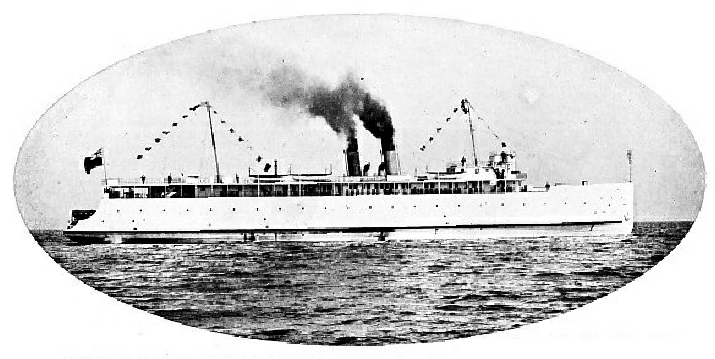
THE CAR FERRY ONTARIO AT FULL SPEED ON HER 56 MILES’ JOURNEY ACROSS LAKE ONTARIO
THERE is one phase of railway working which is foreign to Great Britain. This is the train ferry. In these islands the interruptions of water, such as the estuaries of rivers, when they dispute the advance of the railway-
Meantime, the rapid growth of trade had prompted inventive ingenuity to discover another practicable way of surmounting the hindrance. The great lines which radiate to all parts of the country, in a natural desire to get into touch with the Empire City, have brought their lines to the water’s edge on the New Jersey shore. At these points passengers change to a ferry, to be transported direct across the river. With merchandise, however, such a system was quite impracticable. The goods could not be unloaded on the New Jersey shore into barges, transferred to the opposite bank, and there handled once more: this practice would be slow and increase transport charges. Accordingly, it was decided to convey the trucks intact across the river.
These water-
From the British point of view, this seems a round-
With this fleet of floats dodging to and fro the stretch of Hudson River washing Manhattan Island is a bustling scene of activity throughout the twenty-
When the heavy winds which occasionally sweep up the Hudson estuary rage, the floats do not stop. The going is harder, that is all, but this handicap can be overcome by lashing two or even three of the powerful tugs to a load, to drive against Old Boreas. Even fog, which generally disorganises locomotion, has little effect upon this traffic. The vessels plough their way through the white blanket, whistling and shrieking for all they are worth, with the skipper of the tug keeping a sharp eye and ear on everything around him. When New York is gripped by the fog fiend, Bedlam is let loose. It is a discordant din: bells, sirens, whistles, fog-
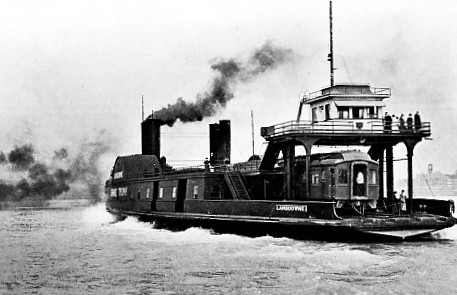
THE DETROIT RIVER TRAIN FERRY LANSDOWNE
This boat can carry a train of eight cars each measuring 72 feet long.
Whose ingenious mind first conceived the idea of carrying trains intact across intervening wide stretches of water is not recorded. Certainly the idea originated in Britain, was transported, adopted, and developed in America, and since has reached its highest development in Europe and Asia. At all events an English shipbuilding firm, Wigham-
The issue was forced upon the United States when the railway expansion westwards and southwards ensued. But unfortunately the strategical points, which were certain to develop into great railway centres, are cut off on one side by wide sheets of water. San Francisco is situate at the extreme tip of the spit of land forming the western arm of the bay. Immediately opposite, on the mainland, is Oakland. The trains from the east came to a dead stop at this point -
The present San Francisco ferries are some of the finest of their class in operation. The west-
The same system has had to be adopted on the wider part of the Mississippi and Columbia Rivers. New Orleans is about one and a half miles away from Algiers. All traffic between the two points over the intercepting width of the Mississippi is negotiated by the train ferry. On the Columbia River, just above Portland, a similar state of affairs exists, as the waterway is two miles in width.
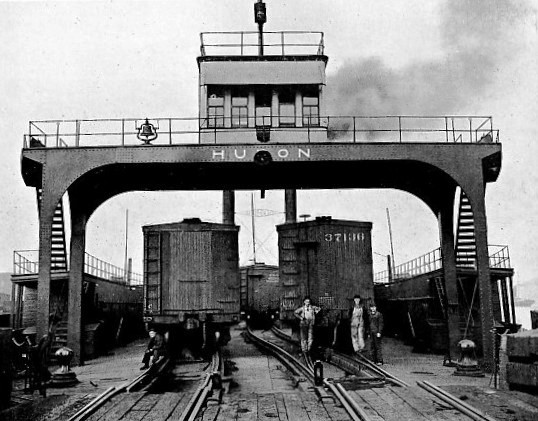
THE TRAIN DECK OF THE HURON, WHICH PLIES ACROSS THE DETROIT RIVER BETWEEN WINDSOR AND DETROIT
It can carry 16 freight cars each 36 feet long.
Rut it is around the Great Lakes that the most imposing illustrations of the possibilities of the floating railway are offered. These seas are transformed into one long waterway by connecting narrow straits, such as the Detroit and St. Clair Rivers. On opposite sides of the channel flourishing towns have sprung up. Thus there are Detroit and Port Huron on the American seaboard, faced by Windsor and Sarnia respectively on the Canadian shore. While the Canadian and American railways come down to the water’s edge on either bank, the growth of international traffic and the flow of produce to and fro could not be interrupted or hindered by a neck of water half-
This practice remained in vogue for several years, but the pressure of the traffic demanded more expeditious means of handling. This was particularly noticeable between Sarnia and Port Huron, as the interruption occurs on the busy main line of the Grand Trunk Railway between Montreal and Chicago. The urgency of improved connection was driven home by the increasing maritime traffic through the St. Clair River, and the fact that movement was impeded seriously by the ice during the winter. So the engineers searched for an easier situation. A bridge was impossible: tunnelling beneath the waterway was the only solution. This was accomplished, and with the opening of the St. Clair Tunnel, providing all-
The foregoing floating railways sink into insignificance, however, in comparison with those in operation upon Lake Michigan. This vast, elongated oval of fresh water is dotted on either side by busy ports, each of which is a teeming railway centre. Obviously, merchandise which has to be sent from one side of the lake to the other cannot be dispatched upon a long haul southwards to round the obstruction, neither is it profitable to load it into lake steamers. The cheapest and quickest method of coping with the traffic is to send it, packed in its trucks, across the water obstruction. There are many busy railway ferry lines, not only running across the extreme breadth of Lake Michigan, but also cutting across it diagonally, such as from Menominee to Frankfort, and from Manistique to Ludington. But the busiest marine railway thoroughfare lies direct across the breadth of the lake, between Milwaukee and Grand Haven, a distance of 84 miles. In order to obtain a more realistic impression of what this means, the sea-
This is probably the busiest highway for this class of traffic in the world, and in its development Anglo-
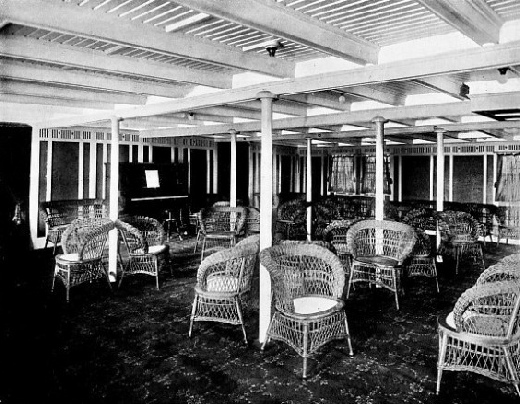
THE LOUNGE ON A CANADIAN CAR FERRY
The Grand Trunk ferries are named respectively Milwaukee and Grand Haven. The former is 350 feet long by 56 feet wide, and 19½ feet deep, drawing 11¼ feet of water when loaded. Her engines develop 3,000 horse-
Her consort, Grand Haven, while a trifle smaller, being 30 feet less in length and 18 inches narrower, reducing her carrying capacity by two freight cars, representing 120 tons, is faster. Her engines, developing 4,000 horse-
The modern Lake Michigan ferry is built of steel throughout, as nothing but this metal can stand up against the heavy battering and pounding of the ice. Although the lakes are frozen during the winter, driving navigation into hibernation for six months, the marine railway line must be kept open. Accordingly, the latest ferries are ice-
If the obstacle is more than usually resistant, the speed of the vessel gradually slows down as she plunges through it, although her propellers are seeking to drive her forward. As the captain and engineer feel that the harnessed steam is being overpowered, the vessel is stopped and backed down the channel she has cut for herself, so as to have sufficient distance to get up speed once more to make another doughty “buck” at the ice.
But running the railway ferries across the breadth of Lake Michigan is not all honey. This sea, in common with the others in the chain, is swept by the most violent storms, when the waves get up as high as any to be met on the Atlantic. Then the ferry has a hard gruelling, especially when the ice is about at the same time. Although staunchly built, engineering science in this field has not overcome completely the forces of Nature. Lake Michigan has its own tale of disaster, and has gathered its victims from the craft which seek to bridge the gap between the respective ends of the railway lines. The year 1909 was particularly black in this respect, and, the ice and storms being abnormally severe, even for Lake Michigan, sad havoc was wrought. The Pere Marquette steel car ferry No. 18 started out on her eastern trip with a full load of thirty laden coal-
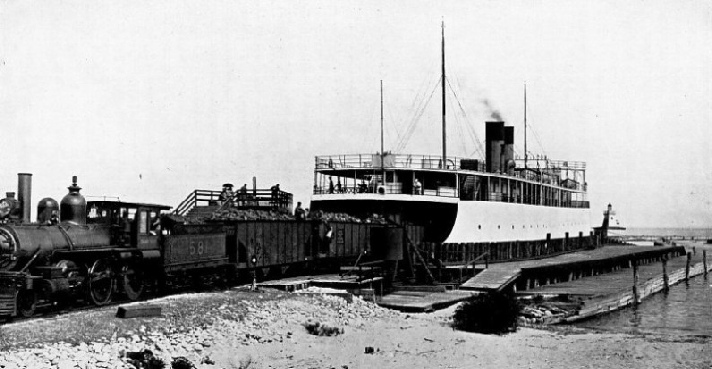
THE ONTARIO BEING UNLOADED OF HER CARS OF COAL
This all-
The craft had barely got well out into the lake, and was ploughing along under full steam, when, with magic suddenness, the Arctic tempest burst over her. The 60-
Instantly the pumps were got to work, and choughed like mad demons in the endeavour to keep the water down. One runaway, after wreaking widespread damage, responded to a heavy pitch of the labouring boat, and took a headlong dive over the stern into the lake. With much difficulty the second was got overboard. But although one danger had passed, another loomed up. The pumps, after working for three hours, became choked with ice, so that the water gained steadily.
There was only one chance to save the boat, and that was to lighten her. The captain gave the command to jettison the cars. It was a simple order, but one which was terrifying to carry into effect, when the ferry was writhing and twisting like an acrobat. Still, the crew, with that grit and determination born of desperation, sprang to the task. The cars were cautiously released when the boat steadied herself for a second or two, and then, in the twinkling of an eye, as the nose of the ferry rose to climb a roller, a car was let loose. The steep declination of the track enabled the cars to rush down with fearful force to smash into the water. Now and again, owing to the ship pitching nose downwards before the truck was clear, the rear wheels caught, and then the men had to toil like demons and with superhuman effort to prise the wheels over.
Meantime the ferry was settling down steadily. All but two of the cars were got off, when the captain gave the men the order to rush for their lives. They hesitated a moment, as the exertions of their task had diverted their attention from the plight of the vessel. But they obeyed the order. They had scarcely drawn clear, and were fighting grimly among the foaming waves, when, glancing backwards, they saw the ferry dip her stern as the bow met an advancing roller. But the stern did not rise as it should have done the succeeding instant. Instead, it was swamped, and never was seen again. The ferry sank like a floating tin which suddenly has its stability destroyed. The men pulled hard for the shore, no easy task in such a sea and with the thermometer well down below freezing point: of the forty who put out from port only two got ashore.
The method of bringing these floating railways into line with the land tracks at the water’s edge is somewhat novel. The area for docking the vessel, which is just large enough to accommodate her and no more, is given a substantial fence of massive timber piles, the line of which follows the contour of the ship from the stern to amidships. The vessel backs into this enclosure very steadily, presently bumping gently against the fence. The piles give a trifle to the blow, but at the same time they guide the movement of stern until at last it strikes the end of the dock, when, the metals coming into line, bolts are dropped to hold the vessel firmly in position. In tidal waters connection between the railway and the ship’s deck is maintained over a bridge, one end of which can be moved up or down to overcome the difference in level between the tracks on land and on board respectively.
On the other lakes, ferry services are maintained between important railway points on the opposite shores. Thus the Straits of Mackinac, where the waters of Lakes Michigan and Huron mingle, are spanned by these massive steel craft. These particular ferries, however, do not ply only between the facing railway terminals located on the respective banks, but at times embark upon coasting journeys, carrying their ponderous loads 60 or 70 miles down the shores. Lake Erie is spanned between Port Stanley on the Canadian side and Conneaut, Ohio, while Lake Ontario is bridged similarly between Cobourg, Ontario, and the Port of Rochester, in the State of New York, the sea journey being 56 miles. The ferry engaged on this service, Ontario No. 1, is a particularly fine example of the American-
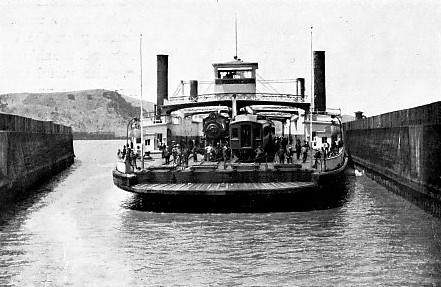
HOW ENGINES AND TRAINS ARE TRANSPORTED INTACT
You can read more on “The Dover-
You can read more on “Train Ferries” in Railway Wonders of the World